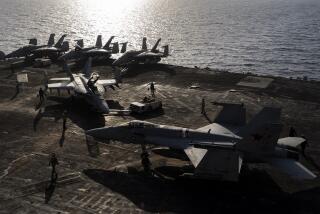For Special Deliveries to Carriers, It’s COD
- Share via
Before a recent trip to the aircraft carrier Independence off the coast of Southern California, I thought a cod was a fish or, maybe, a hook-shaped peninsula as in Cape Cod.
But there is another kind of COD. It is a small, propeller-driven aircraft that delivers supplies and passengers to Navy aircraft carriers. It lands and is launched much like the fighters and bombers that operate from the big carrier decks. COD, in Navy talk, means Carrier On-board Delivery.
“We’ll pick up the COD at North Island Naval Air Station early Friday,” Marine Maj. Jim McClain said as he outlined the final details on our trip to the carrier to do a story on pilots from El Toro Marine Corps Air Station.
“You’ll really like this one,” a sailor at North Island said, snickering, the next day. He pointed to the aircraft, which still had its wings folded. The plane was 57 feet long, with an 81-foot wingspan.
Now I was being strapped into my seat in the C-2A. I nervously glanced across the aisle at Times photographer Don Kelsen. There were 24 others on the plane, including former astronaut Wally Schirra, a VIP who was visiting the carrier. Unfamiliar straps crisscrossed my body. And the Navy puts its passenger seats facing the rear of the plane because, officials say, tests show this greatly improves the chances of survival in case of a crash. The inside of the plane is heavily padded, as if trouble is anticipated.
Forty minutes after we took off from North Island we landed on the carrier deck. A hook on the tail of the plane caught a cable. The stop was about the most abrupt I had ever experienced. It was my first landing on an aircraft carrier.
“You think that’s bad, wait until you take off,” a sailor aboard the ship commented.
The next day, I was back in the COD about to be catapulted off the deck of the Independence. As the plane taxied into position on the starboard side, the crew chief was giving final instructions for the launch.
The pilot eased the throttles to full power and the C-2A quivered.
Sitting backward in the plane, the acceleration from the steam catapult took us from zero to 135 m.p.h. in two seconds and made me feel as if I should push my eyeballs back into my head. When we left the 175-foot-long catapult track, there was a moment of what seemed like absolute quiet. I wondered if everything was working OK. Then the propellers took hold and we were flying.
Once on the ground, I had to ask Schirra about the launch. Here’s a former Navy flier who had done his share of “cat shots” from aircraft carriers. He was the third American in orbit, and was shot into space as part of the Mercury, Gemini and Apollo projects.
“It didn’t feel right. I think we should have been sitting forward, not backwards,” the former astronaut said. “I didn’t like it.”
More to Read
Sign up for Essential California
The most important California stories and recommendations in your inbox every morning.
You may occasionally receive promotional content from the Los Angeles Times.










